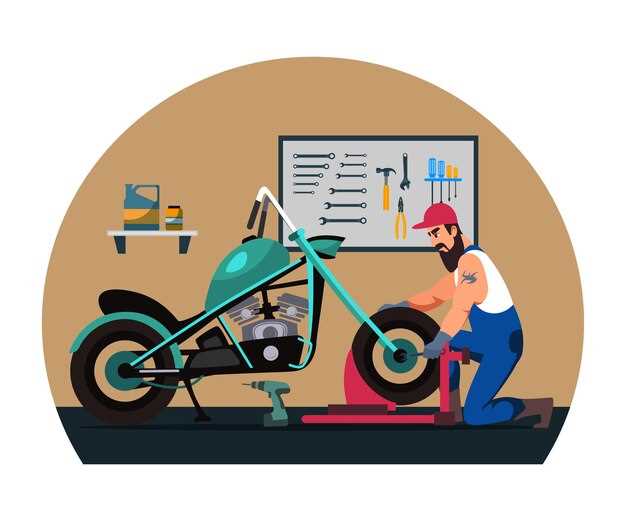Explore the evolution of motorcycle design to understand its profound effect on the riding experience. Each decade has contributed distinctive aesthetics and engineering advancements, shaping not only the bikes themselves but also creating a unique riding culture. By examining specific models and trends, you can appreciate how design influences performance, comfort, and style.
Consider the iconic Harley-Davidson Knucklehead from the 1930s, famous for its innovative V-twin engine. This design not only enhanced power but also set a standard for American motorcycles. Fast forward to the late 1970s, when the introduction of cafe racers showcased minimalist style combined with speed, reflecting the desires of a youth culture eager for freedom and expression.
The 21st century brought about a surge in technological integration. Bikes like the BMW K1600 demonstrate how luxury design combines with cutting-edge technology, offering unparalleled comfort for long-distance riders. Understanding these shifts can inspire current and future designers to think about how aesthetics and functionality can coexist, paving the way for the next generation of motorcycles.
The Evolution of Motorcycle Aesthetics
Examine the transition from classic chrome finishes in the 1940s to the sleek minimalist designs of the 21st century. Each decade introduces distinct characteristics reflecting cultural shifts and technological advancements. The 1950s showcased bold colors and retro lines, emphasizing individuality and freedom of expression. Motorcycles began to feature more sculpted frames and eye-catching graphics, appealing to a growing youth market.
In the 1970s, the emergence of Japanese manufacturers like Honda and Suzuki brought innovative designs that prioritized aerodynamic shapes. This era defined the sportbike style, favoring performance over luxury aesthetics. The aesthetic choices were deeply influenced by racing, resulting in vibrant racing stripes and aggressive stances that captivated riders.
During the 1980s and 1990s, the cruiser trend gained ground. Harley-Davidson led the way with machines that embodied Americana. The aesthetics leaned heavily on nostalgia, featuring detailed chrome work, leather accents, and vintage-inspired elements that evoked a sense of rugged adventure.
The turn of the millennium marked a shift towards customization. Enthusiasts embraced personalized designs, resulting in unique paint jobs and bespoke modifications. This era saw an explosion of styles, from bobbers to café racers, reflecting personal taste and creative expression.
Today, manufacturers are prioritizing sustainability alongside aesthetics. Electric motorcycles introduce sleek, modern designs with clean lines that convey a futuristic vibe. New materials like carbon fiber and innovative lighting technologies influence not only the look but also the efficiency of motorcycles. Riders now have a wide array of choices that blend performance, aesthetics, and eco-friendliness.
The evolution of motorcycle aesthetics is driven by the riders themselves, who continuously seek to balance style, performance, and individual identity. As trends shift, the motorcycle remains a canvas for personal expression and technological innovation.
Technological Innovations Shaping Motorcycle Performance
Enhanced fuel injection systems maximize engine efficiency. These systems offer precise control over the air-fuel mixture, resulting in improved throttle response and reduced emissions. Advances in electronic fuel injection (EFI) have led to significant gains in horsepower while maintaining fuel economy.
Lightweight materials like carbon fiber and aluminum alloys contribute to better handling and acceleration. Using these materials reduces overall weight, allowing for quicker maneuverability and improved braking distances. Manufacturers increasingly incorporate these options in both sport and touring motorcycles.
Anti-lock braking systems (ABS) enhance safety. By preventing wheel lock-up during sudden braking, riders maintain better control and stability. Many modern motorcycles come equipped with ABS as a standard feature, showcasing its importance in performance and rider safety.
Cornering stability control systems utilize advanced sensors to optimize traction during leaning. This feature allows riders to navigate sharp turns with confidence, minimizing the risk of skidding. Such technology continually monitors the bike’s position and adjusts power delivery accordingly.
Digital dashboards provide vital information at a glance. By integrating GPS, speed, and engine metrics into a single display, riders can make informed decisions quickly. Some models even offer customizable settings for different riding conditions, enhancing the overall experience.
Smartphone connectivity through Bluetooth allows riders to manage calls and navigation without distractions. This integration improves situational awareness, enabling a focus on the road ahead, which contributes positively to performance and safety.
Lastly, adaptive suspension systems automatically adjust settings based on road conditions and rider input. This technology enhances comfort and control, adapting to varied terrains and riding styles for an optimized experience.
Influence of Motorcycle Design on Rider Safety Standards
Modern motorcycle design significantly enhances rider safety through innovations focused on stability, visibility, and protective gear integration. Manufacturers now prioritize aerodynamic shapes that minimize drag while maintaining balance, directly impacting handling during high-speed scenarios.
Key design elements include the introduction of anti-lock braking systems (ABS), which prevent wheel lock-up during sudden braking, reducing the likelihood of accidents. This technology is now standard in many models, reflecting a shift towards safety-oriented engineering.
Frame construction has evolved with the use of lighter yet stronger materials, such as aluminum and carbon fiber, which improve impact resistance while keeping the bike maneuverable. This shift not only enhances performance but also contributes to safer riding experiences in various conditions.
Visibility is also a major focus. LED lighting systems offer brighter illumination, improving nighttime visibility and ensuring that riders are seen by others on the road. Design advancements in helmet technology also play a crucial role, providing better visibility and protection through improved fit and helmet aerodynamics.
Rider apparel now incorporates advanced materials and designs aimed at safety. High-visibility colors, reflective strips, and padding contribute to accident prevention and lower injury rates. Manufacturers are increasingly collaborating with gear designers to ensure that clothing and protective gear complement the bike’s design while maximizing safety features.
Lastly, educational initiatives often accompany new models, emphasizing the importance of safety gear and responsible riding practices. This comprehensive approach to design and safety fosters a culture of awareness and preparedness among riders.
Cultural Movements Reflected in Motorcycle Styles
Motorcycles serve as a canvas for cultural expression, mirroring societal changes and beliefs throughout their history. The café racer style, emerging from the UK in the 1960s, highlights a youthful rebellion and the desire for speed. Riders modified standard bikes for lightweight performance, embracing a minimalist aesthetic that resonated with the rock and roll culture of the era.
The chopper scene, popularized by American veterans returning from World War II, symbolizes freedom and individuality. These customized motorcycles reflect a countercultural movement, showcasing personal artistry through extended forks and distinctive bodywork. The film “Easy Rider” solidified this style as an icon of the 1960s countercultural revolution, portraying a search for freedom on the open road.
In the late 1970s, the punk movement influenced motorcycle design with raw, edgy styles. Custom bikes often featured bold colors and unconventional parts, aligning with the DIY ethos of punk bands. This look spoke to a generation rejecting mainstream norms, emphasizing self-expression and rebellion.
Later, the rise of the cruiser style in the 1980s and 1990s catered to a growing desire for comfort and nostalgia, echoing the classic Americana spirit. Manufacturers like Harley-Davidson capitalized on this trend, crafting machines that celebrated a sense of heritage and camaraderie among riders.
Contemporary motorcycle designs reflect environmental awareness and technological advancements. Electric motorcycles, such as those produced by Zero and Harley-Davidson’s LiveWire, represent a shift towards sustainability. These innovations attract a new generation seeking eco-friendly modes of transport without sacrificing style.
Embrace motorcycles not just as machines but as expressions of cultural identity. Each style encapsulates unique stories of past movements, connecting riders through shared values and shared history.
Environmental Considerations in Modern Motorcycle Design
Innovative manufacturing techniques prioritize sustainability. Utilizing lightweight materials like aluminum and carbon fiber reduces overall vehicle weight, improving fuel efficiency and lowering emissions. Additionally, manufacturers increasingly adopt recycled materials in production, minimizing waste and resource exploitation.
Electric motorcycles gain popularity, offering a cleaner alternative to traditional combustion engines. Brands like Zero Motorcycles and Energica lead the charge, providing models that emit zero tailpipe emissions while delivering impressive performance stats. Transitioning to electric drives not only cuts down on pollutants but also reduces noise pollution, enhancing urban riding experiences.
Advanced engine technologies, such as fuel injection systems and variable valve timing, increase combustion efficiency. These innovations help optimize fuel usage and reduce harmful emissions significantly. Future models may integrate even smarter technologies, utilizing AI to adjust performance parameters based on riding conditions, further enhancing environmental benefits.
Motorcycle companies often design with aerodynamics in mind, using streamlined shapes that reduce drag. This approach lowers energy consumption, especially at highway speeds. Styling options are not just for aesthetics; they play a key role in improving environmental performance.
Regenerative braking systems found in some electric bikes reclaim energy during braking and feed it back into the battery. This feature enhances efficiency and extends range, reducing the frequency of recharges and minimizing the carbon footprint linked to electricity consumption.
| Feature | Impact |
|---|---|
| Lightweight Materials | Improves fuel efficiency, reduces emissions. |
| Electric Powertrains | Zero tailpipe emissions, less noise pollution. |
| Fuel Injection Technology | Enhances fuel combustion, decreases harmful emissions. |
| Aerodynamics | Reduces drag, enhances energy efficiency. |
| Regenerative Braking | Recovers energy, extends battery range. |
As consumers become more eco-conscious, brands responding to demand emphasize sustainability in their designs. Motorcycle enthusiasts can enjoy superior performance while simultaneously supporting environmental efforts. The future of motorcycle design lies in this harmonious balance between performance and ecological responsibility.
Future Trends in Motorcycle Design and Their Potential Effects
Electric motorcycles dominate the future of design, offering reduced emissions and quieter rides. Manufacturers invest significantly in battery technology, resulting in longer ranges and faster charging times. As battery density improves, expect lighter designs and increased adoption by urban commuters.
Smart technology integration enhances rider experience and safety. Features like adaptive cruise control, collision avoidance systems, and smartphone connectivity become standard. These advancements lead to better navigation, improved communication, and heightened overall security on the road.
- Modular design: Customization gains momentum. Riders can modify their bikes based on personal preferences or needs, leading to a surge in aftermarket sales and services.
- Material innovation: Lightweight composites and advanced alloys reduce weight while maintaining strength. This results in improved performance and fuel efficiency.
- Eco-friendly practices: Sustainable manufacturing processes gain traction. Brands prioritize recyclability and responsible sourcing of materials, catering to environmentally conscious consumers.
Augmented reality (AR) will play a role in motorcycle riding, providing heads-up displays for navigation and performance metrics. This technology offers seamless access to critical information without distracting the rider.
- Risk reduction: Enhanced technology improves overall safety through better rider awareness.
- Increased participation: The appeal of electric and smart motorcycles may attract new riders, diversifying the riding community.
- Less environmental impact: Adoption of electric models results in quieter urban areas and reduced pollution.
As design trends evolve, addressing the needs of the next generation of riders becomes imperative. Balancing innovation with tradition ensures that the joy of riding remains at the forefront of motorcycle culture.







